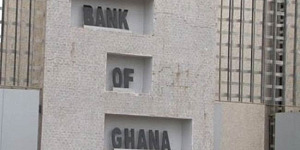Ghana's central bank cut its Monetary Policy Rate (MPR) by another 100 basis points to 22.50 percent as inflation and inflation expectations are trending downwards and said it would take "necessary policy action to move headline inflation towards the medium term target."
The Bank of Ghana (BOG) has now cut its rate by 300 basis points this year following a 200 point cut in March and by 350 points since November 2016 when it began an easing cycle.
In his first monetary policy statement since taking over as BOG governor last month, Ernest Addison said the disinflation process was supported by the bank's tight policy stance and a stable exchange rate of the cedi.
And with outlook for a return to the path of fiscal consolidation and a stable exchange rate, headline inflation is expected to trend toward the BOG's target of 8 percent, plus/minus 2 percentage points, in 2018.
"Given these considerations, the Committee judged that the downside risks to growth outweigh the upside risks to inflation in the outlook, and therefore decided to reduce the policy rate by 100 basis points to 22.5 percent," said Addison who took over after Abdul-Nashiru Issahaku resigned April 1.
Ghana's headline inflation rose slightly to 13.0 percent, the first rise after six consecutive months of decline, from 12.8 percent in March but this was mainly due to higher transport costs.
The central bank's core measure of inflation, which strips out energy and utilities, eased to 13.7 percent in April from 14.6 percent in December 2016.
Ghana's economy slowed last year to growth of 3.5 percent from 3.9 percent in 2015 and forecast growth of 4.1 percent due to a sharp decline in industrial growth following an energy crises and operational challenges in crude oil production for most of the year.
But the BOG said the composite index of economic activity suggested a pickup in growth in the first quarter of this year, helped by private sector credit and exports.
Provisional data on government finances for the first quarter showed a cash deficit of 1.5 percent of Gross Domestic Product, consistent with the target, while expenditures were broadly contained at 11.5 percent of target while revenue and grants were 14.3 percent short of target.
Financing of the deficit was mostly from domestic sources, including a drawn down on government deposits at the central bank, Addison said, adding total public debt at the end of March amounted to 127.1 billion cedi, or 62.5 percent of GDP, up from 73.3 percent end-2016.
Last month Addison said the central bank would not finance the government's budget, something the country agreed to as part of a three-year, April 2015 deal with the International Monetary Fund that aims to restore fiscal balance after years of high deficits, rising debt and high inflation.
Data for the first four months of this year showed a significant recovery in exports on higher output and prices of gold and crude oil, resulting in a trade surplus of an estimated 2.5 percent of GDP compared with a deficit of 2.2 percent in the same period last year.
Ghana's Gross International Reserves surged to US$6.4 billion at the end of April from $4.9 billion at the end of 2016, the equivalent of 3.7 months of imports.
Ghana's cedi fell sharply in 2013 and 2014 but the decline slowed from mid-2015. After rising in March, helped by a US$1 billion cedi bond and the central bank's first quarter auction of US$120 million, the cedi has depreciated this month.
Addison said the volatility in the foreign exchange market that was seen around the last monetary policy meeting in March had eased significantly, with a positive outlook based on expected inflows.
The cedi was trading at 4.42 to the U.S. dollar today, down 3.2 percent this year.






































